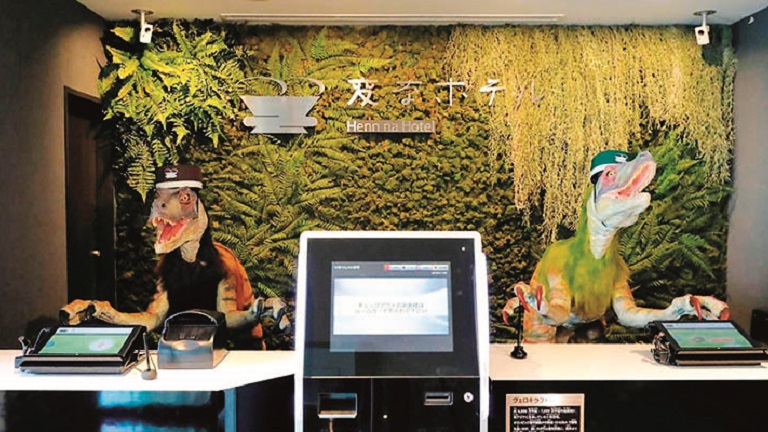IoT and Hospitality: The Robot will serve you

In the world of tomorrow, service robots and automated assistance systems will serve us just like human waiters used to do. But is the industry ready for the next technological revolution – IoT and hospitality?
Robots used to be stationary machines; powerful and usually expensive automation systems programmed to do repetitive tasks. For example, industrial robot arms repeat the same action over and over again with the utmost precision. Service robots, on the other hand, open up a new field – one of flexible, semiautonomous, or fully autonomous, robotics. It is no longer just about automating certain human tasks. It’s more about flexible and (partially) autonomous robots enabling new and much more complex workflows. In short, robots are no longer one-trick ponies that automate a single task. Thanks to falling component costs, technological advances, and novel business models, robotics is finally leaving the realm of science fiction. Service robots will soon be commonplace in hotels, hospitals, restaurants, warehouses, and retail stores, and even in our homes, performing staff services and housekeeping tasks.
The Time Has Come
The hospitality industry is a perfect example of the emerging worldwide market. Products are available from established manufacturers like Savioke and Omron Adept, as well as start-ups like Fetch Robotics and Fellow Robotics in the US, and Robotise in Germany. In addition, there are humanoid robots such as Kuri from Mayfeld Robotics in the US and Pepper from Japan’s SoftBank Robotics (formerly Aldebaran Robotics, France). All of these companies are in the process of developing disruptive technologies (IoT and hospitality) and making them useable for new applications and markets.

Service robots will soon be standard at any hotel.
Robert Brunner, B’Impress
“Robots are booming – this applies both to the industrial sector and increasingly also to private use,” says Martin Hägele, chairman of the Service Robotics Group at the International Federation of Robotics (IFR). “The growing interest in service robotics is partly due to the variety and number of start-ups that currently make up 29 percent of all robot companies. In addition, established large companies are increasingly investing in robotics, often through the acquisition of start-ups.”
The European manufacturers of service robots already play an important role in the global market, accounting for 290 out of the 700 registered providers. North America ranks second with around 240 manufacturers and Asia is next with around 130 manufacturers.

At Your Service The robo-server SaviOne by Savioke supplies snacks, allowing staff to focus on the less-mundane needs of their guests.
In the US, around 200 of the providers currently working on new service robots are start-ups, compared with 170 in the European Union and Switzerland, followed by Asia with 115 start-ups. Virtually all economies are seeking to create a vibrant, entrepreneurial business environment to support service robotics.
IoT and Hospitality: Help Wanted
In many areas of the service sector, kiosk or assistant robots have found their way into everyday life. None of these humanoid robots will replace people in the foreseeable future but they help out in times of bottlenecks or to help remove mundane tasks to make jobs more attractive, especially in areas where there is a chronic shortage or high turnover of staff. Effectively, robots enable employees to work better, faster, and safer. People are elevated to leadership roles or can be freed up to perform higher-value activities, as subordinate or repetitive work is delegated to service robots. In restaurants or hotels, the use of robots relieves the staff of routine tasks and ensures consistent quality and reduces, for example, the risk of wasting food by exceeding the best-before date (or expiration date). In hotels, robotic delivery can replace some room service duties, routine internal delivery services, or even take over maintenance tasks.
One of the current advantages of robots in public areas of restaurants and hotels is to generate excitement and advertising impact, especially while the majority of competitors don’t have them. But, in the long term, service robots will eventually become standard tools and raise the service portfolio and level.

At Your Service The robo-server SaviOne by Savioke supplies snacks, allowing staff to focus on the less-mundane needs of their guests.
SaviOne from Savioke can communicate with elevator and telephone systems to perform its job. The robot is about 90 centimeters tall, weighs about 45 kilograms, and moves at walking pace. Most SaviOnes have been commissioned by hotels in California, where they supply snacks and other essentials, allowing hotel staff to focus on the less-mundane needs of their guests.
ABB’s Yobot is a robotic arm used as an automated baggage storage and retrieval system in the Japanese Hennna Hotel in Sasebo, and in the lobby of some of the largest New York hotels. At Hennna, which famously features service robots in its “hands-off” lobby, Yobot is theatrically illuminated and housed behind a secure glass enclosure. Its main use is to store bags for guests who have signed out of their rooms but are not immediately ready to leave. On being shown a barcode receipt, the robot picks up the guest’s luggage from one of the 117 lockers and delivers it to them.

Short Order: Flippy, the fast-food kitchen assistant from start-up Miso Robotics, can deep-fry food or flip burgers.
Royal Caribbean’s Anthem of the Seas, the world’s third-largest cruise ship, offers innovative entertainment, novelties, and drinks at its Bionic Bar. In the middle of the bar stand two large robotic arms, bent to emulate human elbows, ready to serve a predefned robot cocktail or a traditional classic. Beyond mixing cocktails, automation of food preparation in the catering industry has increasingly become an area for the use of robots. One example is the Flippy fast-food kitchen assistant from start-up Miso Robotics which can deep-fry food or flip burgers.

Quick Service Mobile robots such as Omron’s LD-60 are already being used by hotels in linen and room service delivery.
Moley Robotics intends to take food preparation one step further in more professional kitchens. This design has two robotic arms with skilled “hands” that can learn and repeat the actions of a master chef preparing a gourmet meal. Moley is also planning to release a consumer version of its Robotic Kitchen later this year which will integrate the four kitchen elements: robotic arms, oven, hob. and touchscreen device.

Gourmet Robot Moley Robotics uses two robotic arms to prepare gourmet meals under instruction from master chefs. A consumer version will be out by the end of this year.
Robotise from Munich is also planning to launch its first IoT and hospitality service robot in the near future. The autonomous, self-propelled delivery robot can run errands from the front desk, act as a mobile minibar, or deliver small gifts to guests – saving staff time by doing small but time-consuming tasks. Robotise calls its robot Jeeves, named after the all-knowing valet (a personal butler) in the very British short novels written by P. G. Wodehouse.
In a typical scenario, a guest would order something via the hotel app on a smartphone, or call the front desk to make a request. A short time later, the guest’s doorbell rings and Jeeves automatically opens the appropriate delivery compartment to deliver gifts, fresh towels, toiletries, or drinks and snacks.
The end of the Minibar
Stocking up the minibar is a time consuming and unpopular activity for hotel staff – and the energy costs of the cheaply manufactured refrigerators are not to be underestimated. A service robot as a “rolling minibar” could bring relief and allows a wider selection of fresh snacks and drinks to be supplied.

Large companies are increasingly investing in robotics, often through the acquisition of start-ups.
Martin Hägele, CEO, Service Robotics Group
A service robot also allows the hotel to provide additional services. For example, some hotels have cutoff times for room service because many of them radically reduce staffing at night. If only one person is on the reception desk overnight, they cannot leave to perform messenger services, but a service robot ensures punctual deliveries without disruption.

Carry On, Jeeves! Robotise’s robo-valet Jeeves, named after the manservant in novels by P. G. Wodehouse, runs errands, serves drinks, and even delivers small gifts.
We are just at the beginning of the rise of the service robots in Europe but they will soon be a standard part of any hotel’s provisions – and the robots’ capabilities and intelligence will grow. So next time you order something in your hotel room, don’t be surprised if you open the door to find a robotized butler named Jeeves.

Sign up for the Avnet Silica Newsletter!
Stay up-to-date with latest news on products, training opportunities and more!

Take a DEEP look into the future!
Get the latest market trends and in-depth trainings on our Digital Event Experience Portal!

Avnet Silica Design Hub
Browse and review hundreds of proven reference designs to accelerate your design process. Our designs can be modified and saved in our AVAIL design tool and then exported to your CAD tool of choice.



